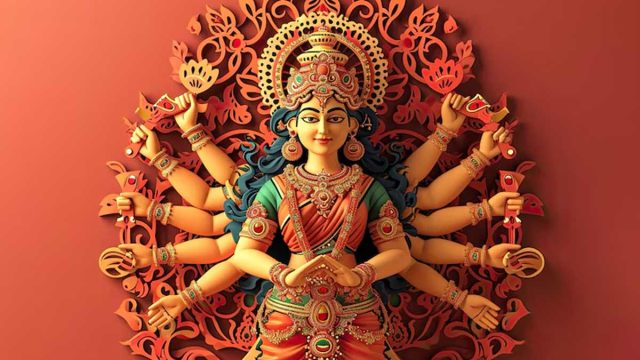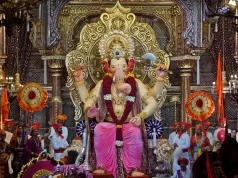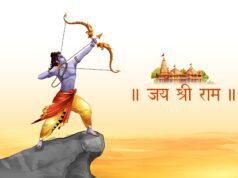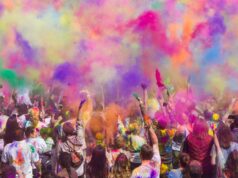Navratri is a festival which is celebrated with great zeal and enthusiasm all over India. Occurring usually in the month of September and October, this festival is observed in honour of Goddess Durga. It spans over nine days and different avatars of Goddess Durga are worshipped with utmost devotion. The word Navratri is derived by combining two Hindi words — ‘Nav’ and ‘Ratri’ which means Nine Days. Therefore, as the name suggests, the festival lasts for nine days and it is celebrated through numerous festivities like Garba, Dandiya etc. Continue reading to find a detailed Essay on the Navratri festival.
Importance of Navratri
India’s calendar is jam-packed with several festivities. These are opportunities to rejoice in life and give gratitude to the various Gods and Goddesses. Navratri is one of the most important festivals, lasting nine days. This celebration serves as a precursor to the Dussehra and Diwali festivities, which occur in fast succession. Navratri occurs in the bright half of the Hindu month of Ashvin, which corresponds to September or October on the Gregorian calendar. The Shakti form of God is typically worshipped during Navratri. Throughout the nine-day festival, the Goddess Durga is worshipped in various forms. This festival marks the prominent battle between Goddess Durga and demon king Mahishasura, it celebrates the victory of good over evil. Navratri is solely dedicated to worshipping the nine reincarnations of Goddess Durga, each of the nine days is associated with every incarnation of the goddess.
The History of Navratri
This Navratri essay recounts the history of the country’s major festivals. Navratri is one of the most auspicious holidays in India. Like the Holi festival, Navratri represents the triumph of good over evil. The festival of Navratri has a long and illustrious history. This auspicious occasion commemorates Goddess Durga’s valiant battle with the demon Mahishasura. He was a buffalo-headed demon who pleased Lord Shiva, so he bestowed the demon with a boon that he would be invincible. However, there was a catch: only a woman could defeat or kill him.
Mahishasura grew in power by attacking innocent people over time, and no Gods could stop him. Lord Vishnu, Brahma, and Shiva eventually decided to create Durga, the embodiment of Goddess Parvathi, to defeat the demon. they also gave her distinct weapons like an axe and a sword. Goddess Durga came to Earth with all of Lord Brahma’s, Vishnu’s, and Shiva’s powers and weapons to defeat Mahishasura. The battle began when Mahishasura fell for Goddess Durga’s beauty and approached her for matrimony. Goddess Durga fought Mahishasura for ten days, deceiving her by changing his forms from human to animal and various shapes and sizes throughout the nine days and on the tenth day he was once turned into a buffalo and slaughtered by the goddess which came to be known as Vijaydashmi, the day of victory.
Celebration of Navratri
After receiving such a blessing, Mahisasura began to regard himself as a deity and began abusing his abilities throughout the world, eventually defeating Agni Vayu and all the gods. Rya Chandra Indra Varuna defeated Agni Vayu, causing a commotion among the gods. Following that, all of the gods went to Brahmaji, Vishnu, and Shiva Ji for help in breaking free from Mahishasura’s rule. As a solution, they requested relief from Mahishasura’s horrors.
Girls are called home and fed as if they were mothers. Durga Maa pandals are also made in other parts of eastern India, such as West Bengal. These pandals draw a large number of worshippers. Durga, the goddess, is revered. Jagran song programs can be found in a number of places. On the ninth day, people here immerse the clay statues of Goddess Durga in water.
Goddess Durga – Nine Forms and Nine Days
Navratri is celebrated with great fanfare and joy throughout the country. Our country is known as Incredible India throughout the world, and we should be proud to be a part of a country that is a melting pot of traditions, cultures, and customs. Dasara is the name given to Navratri in Karnataka. Dasara is a well-known Karnataka festival that takes place in Mysore. Navratri celebrations include dancing, visiting relatives, and handing out sweets. A few people also fast and celebrate with a lavish dinner. The nine days of this celebration are dedicated to the Goddess Durga’s nine incarnations. Each year, the color for these nine days change. The colors ofr year 2022 are given below.
DAY 1 – Shailaputri
Also known as Pratipada [first day], this day is associated with Goddess Shailaputri, an incarnation of Parvati. We also depict her as Mahakali’s immediate manifestation. On the first day, the Goddess is worshipped as Shailaputri, which means “daughter of the mountain.” Shailaputri is Lord Shiva’s consort Parvati. The colour of this day is White, which represents peace and tranquility.
DAY 2 – Brahmacharini
The second day is dedicated to the worship of Goddess Brahamacharini. She is merely the embodiment of Goddess Parvati, but of her unmarried self. Furthermore, the color of the day, Red, represents vibrance and fierceness.
DAY 3 – Chandraghanta
The third day of the Navratri festival commemorates the worship rituals of the Goddess Chandraghanta, the name was given to her due to the half-moon on her forehead. She is the embodiment of beauty and symbolizes bravery. Blue is the colour associated with the third day. It represents emotional balance and being rooted.
DAY 4- Kushmanda
Chaturthi is associated with the worship of Goddess Kushmanda, the name refers to the creative power of the universe. This day is associated with the color Yellow which represents happiness and brightness. Goddess Kushmanda has eight arms and is shown riding a tiger. The goddess represents vegetation on earth.
DAY 5- Skandamata
The fifth day is dedicated to the worship of Goddess Skandamata, she is revered as Skanda’s or Kartikeya’s mother. The colour for the fifth day is Green and stands for tranquility, which represents life.
DAY 6- Katyayani
On the sixth day, we imagine Goddess Katyayani riding a lion with four arms. This avatar is also a representation of bravery. a warrior Goddess represented seated on a lion with four hands. The sixth day’s colour is Grey, which depicts the strength of transforming, and stands for neutrality and balance in the life.
DAY 7- Kaalaratri
On the seventh day, the Goddess Mahakali is depicted in her most ferocious form. To put it another way, slaying demons causes her skin to turn red with rage. Orange is the colour of the day. It signifies peace that overwhelms after the death of evil.
DAY 8- Mahagauri
On the eighth day, Goddess Mahagauri is worshipped who symbolizes intelligence and peace. The colour Peacock Green is associated with compassion and freshness.
DAY 9- Siddhidatri
Finally, on the ninth day also known as Navmi. People pray to Goddess Siddhidatri as she rests on a lotus, exuding nature’s wisdom and beauty. The colour for the final day is Pink which signifies kindness, harmony and affection.
All nine days are associated with all nine different avatars of Goddess Durga with different rituals.








